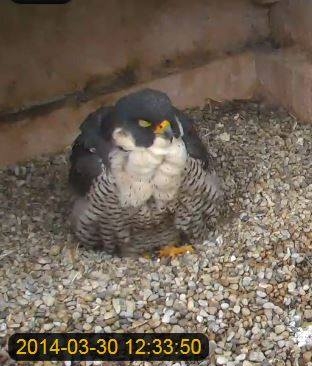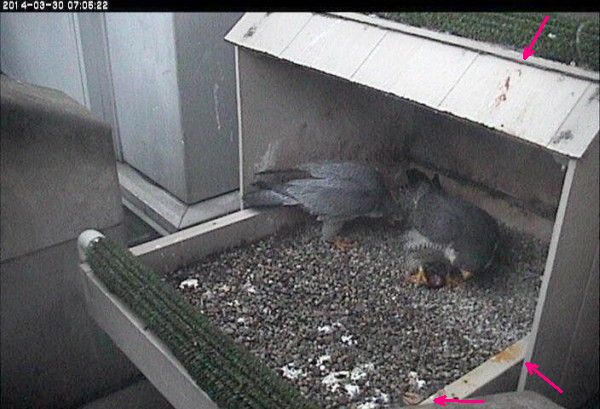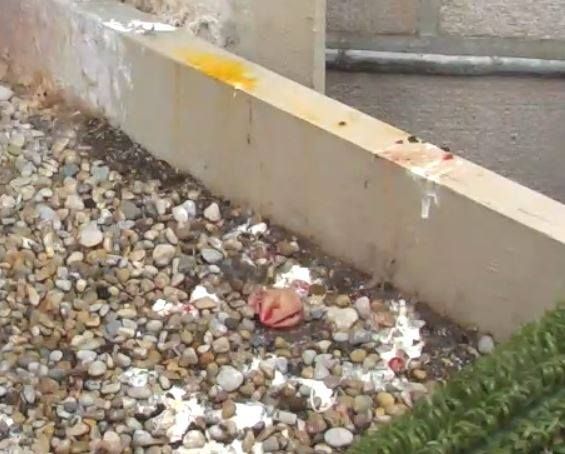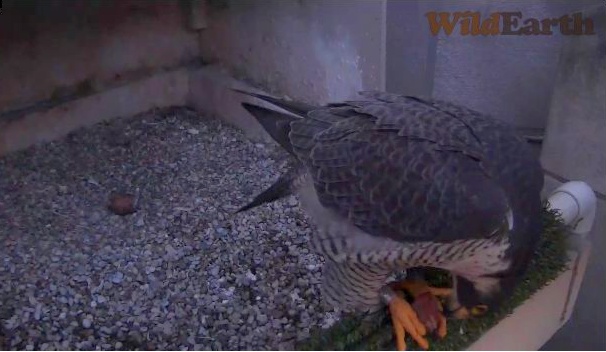
31 March 2014
This is a bird who didn’t feel well. Yesterday Dorothy looked ragged, tired and uncomfortable.
On March 20, she laid her first egg of the season and was due to lay her second on March 22, but nothing happened. During the week that followed she often stood over the scrape, looking as if she wanted to lay another egg. Nothing. We all wondered what was going on. Bob Mulvihill of the National Aviary wondered if she was egg bound.
A bird becomes egg bound when she’s unable to pass an egg that has formed inside her. It’s a serious, sometimes fatal medical condition and is more common in older birds than young ones. At age 15 Dorothy is definitely an older bird, two years older than the average life expectancy of adult peregrines.
Saturday night (March 29-30) Dorothy roosted on the nest box roof. At some point she expelled a red splotch on the roof, a yellow splotch on the right edge of the box, and a deflated eggshell on the gravel. When E2 came to visit at dawn all three signs were visible. He was active. She was not moving very fast.

I saw the yellow splotch at dawn and wondered if it was a yolk. When Bob saw the signs below he knew that Dorothy had been egg bound and it was over.

Since egg binding is life threatening, it’s good news that Dorothy expelled the egg. This morning at dawn she was more alert and even picked up and ate the expelled eggshell. (Female peregrines often eat the eggshells of their hatched chicks.)

However this episode is one more confirmation that Dorothy is in poor breeding condition and unlikely to have a successful nest.
I don’t know what will happen next but I can predict with confidence that some day a new female peregrine will arrive at the Cathedral of Learning and we’ll see eggs and baby peregrines again at Pitt.
I don’t know when.
(photos from the National Aviary falconcams at the University of Pittsburgh)
Thanks for confirming my suspicions; I could tell she was trying to lay, albeit unsuccessfully. Poor girl!
Sad, of course, but I suppose we must prepare ourselves for the inevitable.
I happened to check in midday yesterday (Sunday – don’t know the exact time). I saw E2 standing right in front of Dorothy, repeatedly pointing his beak at the egg under her while squawking his head off. It was like he was telling her to take proper care of the egg but she didn’t respond. He eventually flew off. It was like seeing them break up. Very sad.
Judy, E2 may have been distressed that she wasn’t feeling well & saying he was worried. “Upset” sounds among peregrines are very squawky. I’m sure E2 knows she was feeling lousy.
Like the others, I too have been watching and empathizing with Dorothy–she did her best for as long as she could. I imagine nature will take its course and there will be no more chicks from Dorothy, God bless her. She can “retire” from parenting now, and just try and enjoy what life she has left. Last night as I watched her for quite some time off and on she appeared at one point to be incubating, pushed the egg under her and settled on top of it but at another point she seemed to shove it aside, so as hard as E2 tried he cannot change the course of nature. Hopefully he will find another mate sometime and continue but for now — we’ll all just have to “wait and see” and enjoy them as they are, I guess.
Hi Kate, how would another female Peregrine find the nest? Would it be possible for another female to nest at the Cathedral this year, or is it too late in the breeding season? Thank you in advance for your response!
Peregrines notice potential nest sites as they wander (peregrine means wanderer) and they find other peregrines by sight. During the breeding season those who have a territory/site soar and flap to announce they own it. If they’re available they make an even bigger show to make sure they’ll be seen and approached. Unmated birds who don’t have a territory look for these signs. The Cathedral of Learning is visible many miles away as a potential nesting “cliff.” That’s how a female will find it.
Is there enough time for a new female to nest at the Cathedral of Learning this spring? Yes. April is prime time.
I just saw a female Peregrine at a nest here in Oregon. Apparently she is ready and willing to start a family, but the resident male has little to no interest in mating with her. There was a crowd staked out waiting for the male to make an appearance, but I never saw him over the course of an hour. The nest has to be one of the most easily visible ones that I’ve ever heard, about 100 feet up a wall from the park’s visitor’s center. Maybe E2 and this falcon could meet up.
Here she is: https://flic.kr/p/mBAAFi
Here’s the location: http://www.blm.gov/or/resources/recreation/yaquina/index.php
Good luck Pittsburghers!
Poor Dorothy seems to be struggling again today; so hard to watch her decline. It’s impressive to think how many people, birdwatchers or not, she has helped educate and inspire, just by being her beautiful self.
I stopped by the Neville Island bridge early this afternoon; no sign or sound of Magnum or her mate. I thought I may have heard a brief episode of squawking, but couldn’t say for sure…the ever-present, resident Mockingbird there is indeed talented!
Carolyn, Anne Marie has seen the pair at Neville Island bridge mate several times this spring. Best time to watch seems to be the evening after work
Great blog Kate, I always enjoy your updates. I help out with CCB’s Cobb Island cam, and last year we watched the resident female die after trying to pass an egg for several days. The Wildlife Center of VA did a necropsy to determine she had been egg bound.